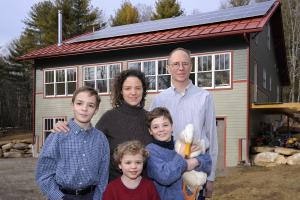- 3 reads

As global concern about energy consumption, greenhouse gas emissions and depletion of non-renewable resources continues to rise, more and more consumers are exploring ways to reduce their home’s energy usage. At the forefront of this conversation is the zero energy home movement.
As early adopters of energy efficiency policies and the zero energy movement, Connecticut developed the Zero Energy Challenge (ZEC), an annual design and build competition that showcases energy efficient single and multi-family homes. The Challenge is managed by electric utilities Eversource and United Illuminating, and exemplifies the positive impact zero energy homebuilding can have on our community and environment.
Since 2010, this nationally recognized competition has challenged builders and homeowners alike to construct high performance homes that consume little to no energy.
This past year’s Challenge featured nine participants, who shattered the perception that “green” homes are expensive. With an average cost per square foot of $139, 2015 proved to be the most affordable year on record for the Challenge. According to HomeAdvisor.com, the national average cost per square foot for a 2,000 square foot home in 2016 is $150.
In addition to the construction cost, the 2015 participants are expected to save, on average, approximately 15,000 kilowatt hours of electricity and almost $3,000 dollars in energy costs, as compared to a home built to residential building code standards. Some of the energy saving building designs, products and materials used in their homes included:
- Salvaged metal kitchen materials from a 1950’s home
- Heat pump water heaters
- Solar photovoltaic systems
- Structurally Insulated Panels (SIPs) for wall and roof insulation
- ENERGY STAR® LED Lighting and Appliances
- High Efficiency Energy Recovery Ventilators
The 2015 Challenge also confirmed that it is more economical to address sustainability through new construction, rather than going back and retrofitting a home with energy efficient upgrades. Some of the advanced technologies and building practices featured in these homes, included:
- 12 Inch exterior wall cavity with R-50 insulation
- Heat Recovery Ventilator (HRV’s) and Energy Recovery Ventilators (ERV’s)
- Ductless Air Source and Geothermal Heat Pump heating systems
- A desuperheater that uses waste heat from the geothermal system to pre-heat the domestic hot water system
For one participant, the overall initial cost of the home’s construction was less than the cost of installing a high performance HVAC system and window package in a similar, older home.
Beyond the energy savings, cost savings and positive economic impact, a more sustainable home delivers tremendous environmental benefits. A zero energy home, on average, reduces carbon dioxide emissions by 30 tons more than a non-zero energy home. Sustainable homes also help boost our energy supply by lessening the electrical load on our power grid, reducing peak demand and the need to build more power plants and infrastructure.
As the zero energy movement gains more momentum, it is important that we continue to keep sustainability in mind when constructing new homes and strive to build to zero energy standards. With a record of 22 participants for the 2016 Zero Energy Challenge, these Connecticut homes are proof that building an energy efficient and eco-conscious home is now more imaginable – and affordable – than ever before.

